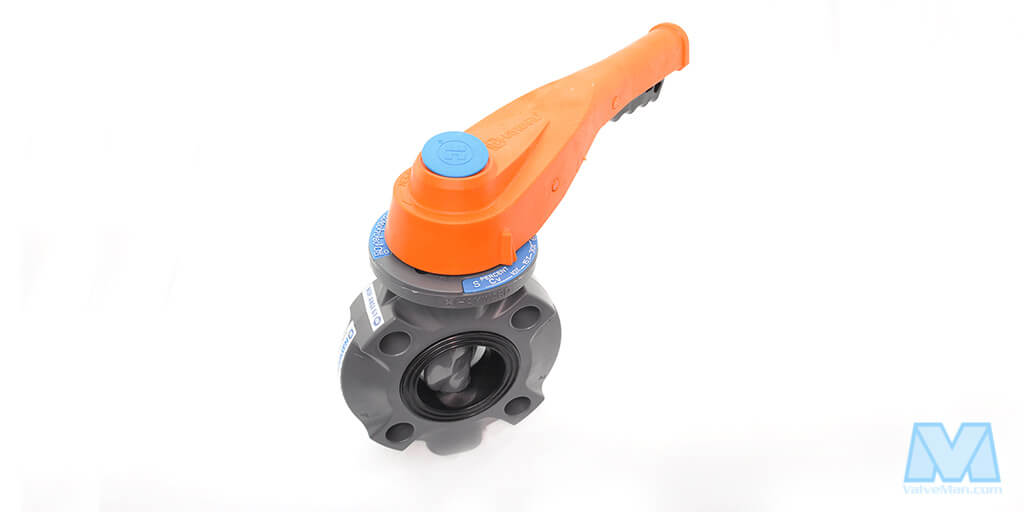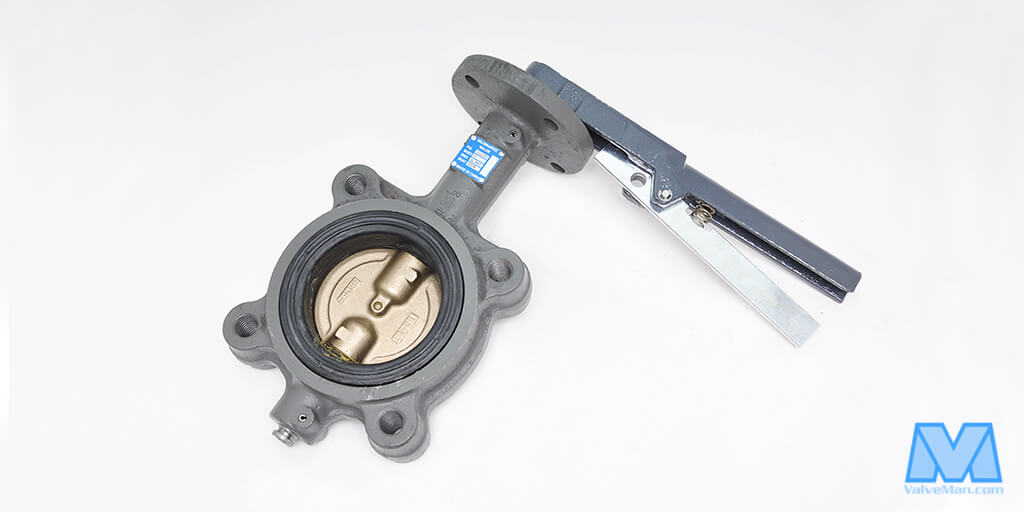
Manual
Manual Butterfly Valves
Shop Manual Butterfly Valves Shop Now
Electric
Electric Butterfly Valves
Shop Electric Butterfly Valves Shop Now
Pneumatic
Pneumatic Butterfly Valves
Shop Pneumatic Butterfly Valves Shop Now
Wafer
Wafer Butterfly Valves
Shop Wafer Butterfly Valves Shop Now
Lug
Lug Style Butterfly Valves
Shop Lug Style Butterfly Valves Shop Now
High Performance
High Performance Butterfly Valves
Shop High Performance Butterfly Valves Shop Now
Grooved
Grooved Butterfly Valves
Shop Grooved Butterfly Valves Shop Now
3-Way
3-Way Butterfly Valves
Shop 3-Way Butterfly Valves Shop Now
Butterfly Valve Overview
Butterfly valves are a useful component in many systems, resulting in them playing a vital part in many different industries. ValveMan carries a wide array of different butterfly valves, so let's take a closer look at their potential uses and advantages.
A butterfly valve is a specific type of quarter-turn valve that consists of two distinct components:
- A circular disc placed inside a pipe or duct
- A rod or shaft connecting the disc to the outer actuator or manual handle

When the handle or actuator is turned, the shaft then turns the disc by a quarter turn to either open or close the valve.
The butterfly valve is comprised of a body, seat, disc, stem, and actuator. The central disc of the body is known as the butterfly and is what gives this valve its name. This butterfly is mounted to the stem and when the valve is switched to the closed position, the butterfly rotates on the stem and prevents the passage of fluid or gas by nestling itself against the round seat of the valve's body, creating a sound seal. To switch the butterfly valve into the open position, the butterfly is moved a quarter turn (hence its quarter turn classification) so that it faces 90 degrees from the seat to allow unrestricted flow of fluid or gas.

Popular Butterfly Valve Types
Manual Butterfly Valves
Manual butterfly valves are operated by a hand lever or gear, making them ideal for systems where flow control adjustments are infrequent. They offer a lower-cost solution with simple operation and are commonly used in low-pressure applications like water distribution, HVAC, and general-purpose industrial systems.
Electric Butterfly Valves
Electric butterfly valves use electric actuators for automated control, allowing for precise modulation and remote operation. These are well-suited for applications requiring integration with control systems, such as water treatment facilities, chemical processing, and HVAC systems that demand accurate flow regulation.
Pneumatic Butterfly Valves
Pneumatic butterfly valves use compressed air to operate quickly and reliably, making them ideal for high-speed automation and applications requiring fast shut-off. They’re widely used in manufacturing plants, food and beverage processing, and chemical applications where reliability and speed are essential.
High Performance Butterfly Valves
High performance butterfly valves are designed to handle higher pressures and temperatures than standard valves. Featuring double or triple offset disc designs, they deliver tight shut-off and long service life. These valves are commonly found in power generation, oil and gas, and other demanding industrial environments.
Butterfly Valve Materials
At ValveMan, you can find a complete range of options for materials in sizes ranging from 1" to 24". Popular materials available at ValveMan include:
-
Carbon Steel
-
316 Stainless Steel (CF8M Cast)
-
316L Stainless Steel
-
304 Stainless Steel
-
Cast Iron
-
Epoxy Coated Cast Iron
-
Epoxy Coated Ductile Iron
-
Ductile Iron
Frequently Asked Questions (FAQs)
How Do I Select the Right Butterfly Valve for My Application?
When trying to find an appropriate butterfly valve for your application, there are a few things to bear in mind. Mainly, choose a material that won't react to the liquid or gas you're transporting. Secondarily, the size of the system. Finally, the type of actuator you need, whether manual, pneumtaic, or electronic. You should be fully aware of what you need before you try to buy butterfly valves.
Can Butterfly Valves Be Automated?
Yes, butterfly valves can certainly be automated. In fact, some of the butterfly valves we carry at ValveMan come are automated with electric actuators or pneumatic actuators.
How Should Butterfly Valves Be Maintained?
Butterfly valves generally require little to no maintenance. However, to ensure that it stays in working condition for as long as possible, you should inspect it regularly, ensuring that sediment and debris don't build up within it. You should also use it regularly to prevent the buildup of corrosion or other problems.
What are the main advantages of using a butterfly valve?
Butterfly valves offer several key advantages, making them a popular choice for a wide range of applications. They are known for their quick shut-off capability, as they are quarter-turn valves that can go from fully open to fully closed with a 90-degree turn of the handle. Their simple, compact design results in a smaller face-to-face dimension compared to other valve types like gate valves, making them lighter and often more cost-effective. They are suitable for various fluids and are known for providing bubble-tight shut-off.
What is the difference between lug-style and wafer-style butterfly valves?
The main difference between lug-style and wafer-style butterfly valves lies in their installation. A lug-style butterfly valve has threaded lugs (or "ears") on the valve body that allow it to be connected directly to the pipe flanges using bolts. This design allows for "dead-end service," meaning you can disconnect the piping from one side of the valve while the other side remains under pressure. A wafer-style butterfly valve, on the other hand, is installed by being sandwiched between two pipe flanges, held in place by long bolts that go through both flanges.
In which applications are butterfly valves most commonly used?
Due to their versatility, butterfly valves are used in a vast number of industrial applications. You will commonly find them in water treatment plants, chemical processing, food and beverage manufacturing, and HVAC systems. They are suitable for handling liquids, gases, and even slurries. The choice between a resilient seated or a high-performance butterfly valve will depend on the specific pressure and temperature requirements of the application.
How do I choose the correct size and pressure rating for a butterfly valve?
Selecting the right butterfly valve involves considering the pipe size, the flow rate (Cv rating), and the maximum operating pressure of your system. The pressure rating of the valve must be sufficient to handle the demands of the application. It is also crucial to consider the material of the valve seat and valve disc to ensure compatibility with the fluid being handled. For high-pressure or high-temperature applications, a high-performance butterfly valve is often the recommended choice.
What are the typical materials used for butterfly valve components?
The materials for butterfly valves are chosen based on the application's demands for durability and chemical compatibility. The valve body is commonly made from materials like ductile iron or stainless steel. The valve disc can be made from stainless steel, ductile iron with a coating like nylon, or other alloys. The valve seat, which provides the seal, is often made from resilient materials like EPDM or Buna-N for standard applications, or from materials like PTFE for more demanding chemical environments. For a high-performance butterfly valve, you might find options with metal seats for higher temperatures.
Where Can I Buy Butterfly Valves?
ValveMan stocks a broad range of different butterfly valves. For the best prices and choices, check out our butterfly valve collection. You may also want to take a closer look at some of our other collections, like high-pressure ball valves and inline check valves.
Butterfly Valves - Related Articles
Actuated Butterfly Valves 101: All You Need To Know About Their Application In Piping Systems
What is the Difference Between Lug and Wafer Type Butterfly Valves?